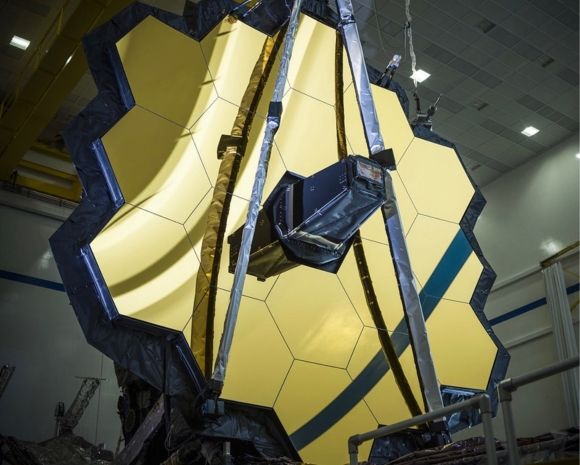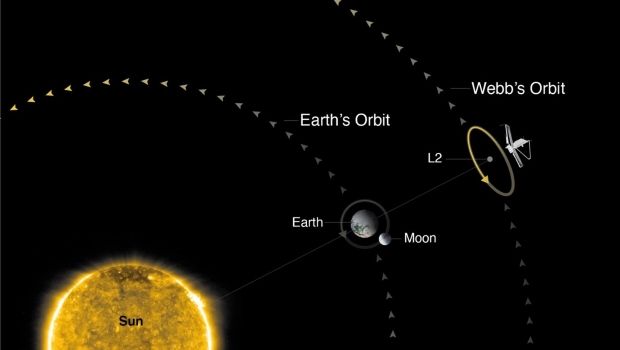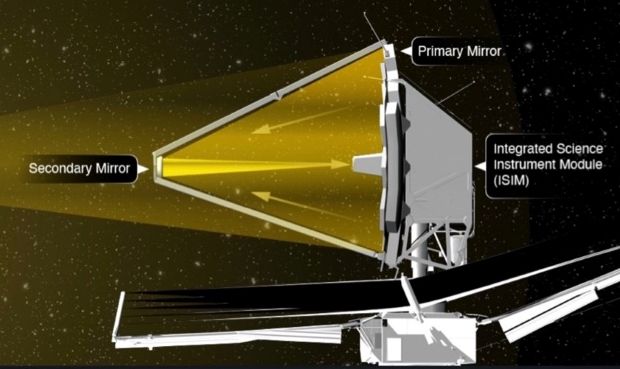The Hubble Space Telescope is a hard act to follow. But if the new space observatory planned for launch from French Guiana on 24th December by Nasa, the European Space Agency (ESA) and the Canadian Space Agency goes to plan, it could have an even more transformative impact, both on astronomy and on public appreciation of space.
The $10bn James Webb Space Telescope (JWST) represents a technological challenge of another order from Hubble. Some of the cosmic images that Hubble obtained have become almost as much a part of public culture as the Apollo “Earthrise” photo, notably the sublime “Pillars of Creation” image showing what look like towering columns of gas and dust in the Eagle Nebula, where new stars are being born. But Hubble’s glittering career began ignominiously after the 1990 launch, when Nasa discovered that its mirror was misshapen. It could send back nothing but blurry images until the crew of the US Space Shuttle was able to correct the optics in 1993. If anything goes wrong with the JWST, however, there is nothing we can do about it. For rather than sitting in a low Earth orbit in the outer reaches of the atmosphere, as Hubble does, it will be 1.5m kilometres away—almost four times further than the moon and well out of reach of any current human spaceflight capability.

That’s already enough to give the mission scientists sleepless nights. But there are many things that could go wrong quite aside from any unforeseen design flaws. The JWST is arguably the most ambitious, and also the most expensive, space mission ever attempted; it is certainly the largest and most powerful space telescope ever built. Its scientific payoff should be huge—but by the same token, failure would be a serious blow to astronomical research worldwide.
The reason for the expense and ambition of the JWST is intimately linked to the science it aims to conduct. Whereas Hubble observed space primarily in the wavelength range of visible light, the JWST will collect light at longer infrared wavelengths: the radiation that is emitted from warm objects. Every wavelength band in the electromagnetic spectrum offers a different window on the universe, revealing different classes of object. Telescopes such as the space-based Chandra X-Ray Observatory can see extremely hot objects and violent phenomena, such as the environments surrounding black holes, while radio telescopes can spot exotic astrophysical objects such as quasars and pulsars. At infrared wavelengths, meanwhile, it’s possible to study the birth of stars from gas and dust coalescing under their own gravity, as well as the formation of planetary systems around them.
Among the most enticing objects that the JWST will look for are the earliest galaxies to have formed in the universe. It used to be thought that galaxies did not begin to appear until at least a billion years after the Big Bang (an event that happened 13.8bn years ago). One of the revelations of Hubble was that galaxies go back considerably further than we thought. When the telescope was turned on what seemed to be a dark patch of sky and left for ten days to collect any faint light it might have been emitting, it discovered that this region was in fact filled with very distant and dim galaxies. The further away they are, the longer their light has taken to reach us, and so the further back in time we are looking: the most distant galaxies we can see are thus also the earliest.
Hubble couldn’t see farther back in time than about 500m years after the Big Bang, however. That’s because the light from the oldest galaxies arrives here as infrared radiation, which is outside of Hubble’s range. Only a telescope sensitive to these wavelengths can hope to see these objects.
But because those early galaxies are also very dim, we can’t hope to observe them with infrared telescopes on Earth. It’s simply too warm here: we’re flooded with infrared light. It would be like trying to see stars with the naked eye from inside a floodlit stadium. Even the telescope itself would radiate so much infrared light that it would drown out such objects. To see them, says Mark McCaughrean, senior adviser for science and exploration at ESA and a project scientist on the JWST, “you need to go somewhere cold.” A low-Earth orbit like Hubble’s is still too warm: you have to venture into deep space.
Then you must decide where to put it. And there’s an obvious location: the JWST will operate from a point in space called the L2 Lagrange point. This is one of the places in the solar system where the gravitational pull from the Earth and the Sun balance each other, so that an object at that position should stay put. At L2 the telescope would in theory remain in place, rotating around the Sun in sync with the Earth. The disadvantage is that we have no way to go out there and do repairs or adjustments if they’re needed. “That’s the risk we have to accept if we want to do this science,” says McCaughrean. “We can’t do it any other way.”

But it’s even harder than that. The telescope can’t sit exactly at L2 itself because it’s an unstable balance—it would be like trying to balance a marble at the centre of a saddle. Instead, the instrument will revolve in a 700,000km-diameter orbit around this point, kept there by little nudges every month or so from an onboard propellant. If it drifts too far off course, it could become impossible to nudge it back.
What’s more, to collect enough infrared light to see very dim objects like the first galaxies, you need a big telescope—too big to fit inside the Ariane 5 rocket being used for the launch. The answer is to fold the telescope up for transit. It is made of 18 hexagonal panels which sit on arms that will open to a diameter of 6.5 metres when the telescope is in space. Each panel, made from ultra-lightweight beryllium metal, then has to be mechanically moved into place. To fit together coherently into a single, smooth mirror, the panels have to line up with a precision measured in millionths of a millimetre—comparable to the size of the Covid virus. This deployment will proceed gradually and carefully over a two-week period.

Sound like a tall order? That’s not even the worst of it. To keep the telescope cold enough, it has to be shielded from the light of the Sun and the Earth. At L2, the telescope will always sit with the same side pointing towards both celestial bodies, and so it can be kept in shadow by deploying a reflecting shield on one side. “The sunshield is the biggest worry,” admits McCaughrean.
For while the mirror sections are rigid and predictable, the huge shield—about the length of a tennis court—is made from five layers of very fine plastic film (Kapton, used for insulation blankets) coated with silver and silicon. This stuff has to be unfurled mechanically in space, and it’s an engineer’s nightmare: floppy and difficult to predict. To avoid any risk of the film snagging, the unfolding has to be done very slowly, by opening more than a hundred confining clips one at a time. Each clip has a small spring that is released electronically, and because they are single-use devices, they can’t be tested prior to deployment (although of course lots of clips of the same design have been tested in advance).
And the shield has to unfurl perfectly. Even if the deployment is 99 per cent of what’s intended, that would still scupper the whole mission, because the sunshield has to reduce the flux of radiation from the Sun by a factor of about a million: 1 per cent of that is still too much. The infrared detectors “won’t even work unless they are cold enough” says McCaughrean—they must be kept at a temperature of below about 213oC.
If all that makes you nervous, it should. Keeping the JWST properly oriented, with the shield constantly blocking the Sun, will be a challenge too. Sunlight falling on the shield will exert a tiny pressure, which in space could be enough to cause the instrument to rotate. To counteract that, there is a system of gyroscopes, which will also be used to swivel the telescope in a perpendicular direction to point it towards the object it is to observe. (The telescope will point at right angles to the shield.) There are limits to how much rotation the gyros can produce, however, and so the onboard propellant will also be used to give it orientating nudges when necessary. But there is only enough propellant to last 10 years—so unless we were to design and launch some robotic mission to refill the cannisters, the JWST has a very definite “use by” date.

As well as looking for the first galaxies, the JWST will look at nearer galaxies and stars, to understand more about how they form and evolve. But one of the most exciting prospects is the telescope’s ability to peek into the atmospheres of the planets orbiting stars other than the Sun—so-called exoplanets—to assess the nature of the planetary environment, and just possibly to find signatures of life.
This was never a part of the original plan. When a successor to the Hubble Space Telescope was first discussed in the late 1980s and early 1990s, the first exoplanet hadn’t even been detected. We have now spotted almost 5,000 of them, generally by looking at how the light from their parent star dims very slightly as the planet passes in front of it along our line of sight. Alternatively, large exoplanets can induce a detectable wobble in their star as they circulate. Such methods have revealed a huge variety of different worlds elsewhere in the Milky Way, some of them very different from those in our own solar system. Among the easiest exoplanets to see are so-called “hot Jupiters”: giant planets similar in size to Jupiter but orbiting much closer to their star, making them much warmer. The very existence of such planets has posed a puzzle for ideas about solar-system formation, since it was long thought from our own experience that giant planets composed mostly of gas would be confined to the further reaches of a planetary system.
The most enticing other worlds are those that look like our own: smaller, rocky planets in orbits where the temperature is likely to be conducive to the presence of liquid water on the surface: the “Goldilocks zone” that is neither so hot as to evaporate the water nor so cold as to freeze it. Several such potentially habitable exoplanets have been seen, but it is very hard to find out much more about them.
One possible way of doing that is to look at the radiation absorbed by the planetary atmosphere. Different chemical compounds absorb and emit light at very specific wavelengths, supplying a kind of fingerprint of their presence. So the atmosphere of a transiting exoplanet acts to filter out some of the starlight passing through it, from the “colour” of which it is possible to deduce which chemicals the atmosphere contains. This has already been done with existing telescopes for a few exoplanets, leading for example to the detection of water vapour in some of them. But the filtering is extremely faint, so you need a very powerful telescope to see it.
Luckily, such atmospheric components typically absorb light in precisely the range of infrared wavelengths that the JWST was designed to detect. So the telescope will make it possible to study exoplanet environments much more extensively and precisely than has been possible so far. McCaughrean says that about a third of the scheduled observing time is designated for studying exoplanets. But even with the telescope’s impressive sensitivity, observing the atmospheres of relatively small, cool Earth-like exoplanets will be “on the outer limits of what can be done,” he adds. So efforts to find out about the composition of those most enticing of exoplanets—and perhaps even to look for signs of life in the chemistry of their atmospheres—would probably consume observation time greedily, needing a month or more, which might have to be spread out in chunks over several years.
Given the magnitude of the questions the JWST will speak to—where we come from, how we got here, whether we are alone in the cosmos—the price tag seems modest. (It is after all barely half of what Elon Musk can make on the stock market in a day.) In contrast to the attention-grabbing but scientifically barren space exploits of Musk and Jeff Bezos, it represents space research truly at its most ambitious and inspiring: an example of “putting ourselves out there” not for commercial but purely for intellectual gain. But it’s going to be a nail-biting ride.












